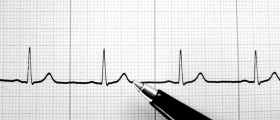
Pulse Rate for Women
Heart rate (also known as pulse) is a heart speed measure. The heart is responsible for delivering the blood to all organs and tissues in the body. By measuring the pulse, you can tell the speed and regularity of the heart. Usually, pulse is checked on the neck and on the wrist, where the veins are most exposed. Feel the pulse with your fingers and count it, measuring one minute on the watch.
Pulse rate varies from 60 to 100 beats per minute (bpm) while resting. The pulse should be measured regularly, so you could define your personal normal pulse condition. Many circumstances may affect the heart rate and increase it. Emotional status, stress or exercising will most certainly cause the increase of the pulse. Knowing your pulse rate is important. It could be used to assess the health of your cardiovascular system or to measure your fitness improvement.
In female babies, up to one year, pulse is higher than in adults and it is usually between 100 to 160 beats per minute. Female kids, 1 to 10 years of age also might have a pulse that varies from 70 to 120 bpm, while in adult female athletes it can be really low, just about 30 bpm.
Measuring the pulse, one may objectively measure the fitness of that person. Usually, pulse is measured in the rest, during the exercise and after the exercise, to see how it changes. Sometimes, fitness is also measured by heart rate recovery after the workout. Any abnormal changes can indicate the possibility of some medical problem. If your heart rate changes significantly, you should consult your doctor.
There are two distinctive pulses: resting heart rate, the one taken after you have been sitting for 15 minutes and heart rate measured (achieved) during the physical activity. There is a rule that says that the appropriate maximal heart rate for you is the one that is 220 bpm minus your age. Specialists advise to keep your heart rate under the maximal recommended while exercising. As you get more fit, it will be noticeable on your rest heart rate and recovery time from working out, too.
Heart Rate Conditions
A woman whose pulse rate is above 100 bpm is considered to be tachycardic. The most likely causes are: exercise and stress, and in some cases other medical conditions, such as fever, lung problems and coronary artery disease. Tachycardia might also be the side effect of some medications.
Bradycardia is the condition when the heart rate is lower than 60 bpm. This is a common condition in women athletes. In situations, when a non-athletic woman suffers from bradycardia, it might be a medical condition, requiring treatment. Hypertension, electrolyte imbalance and underactive thyroid gland could be responsible low pulse rate in these women.








_f_280x120.jpg)








Your thoughts on this
Loading...